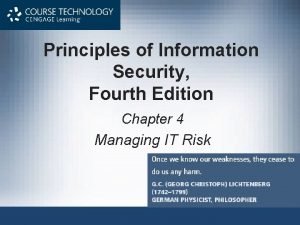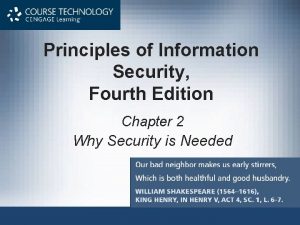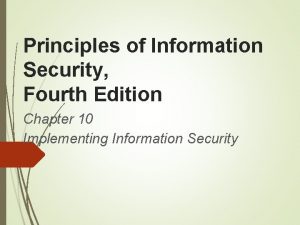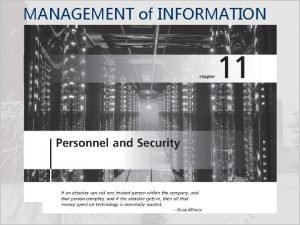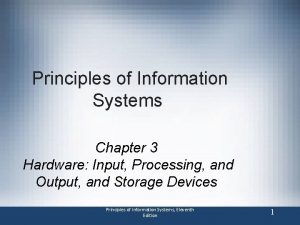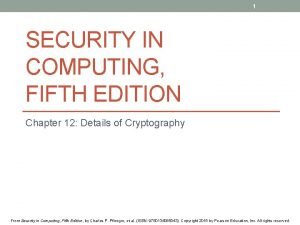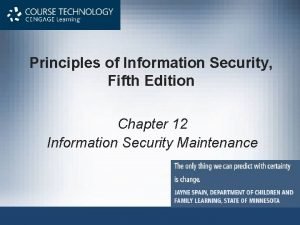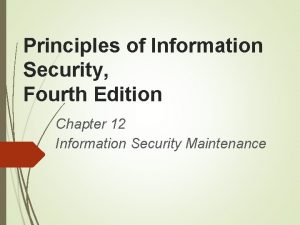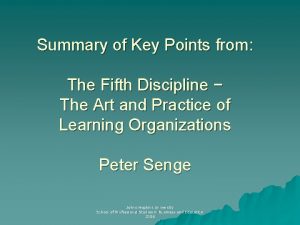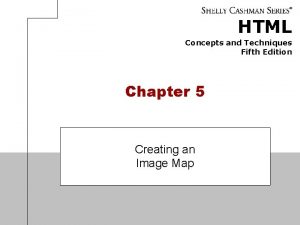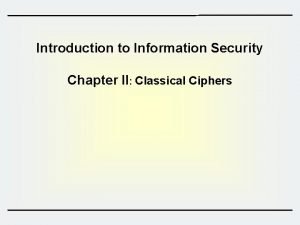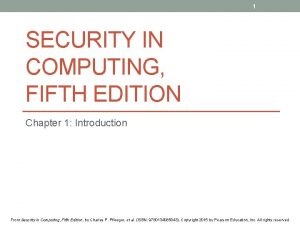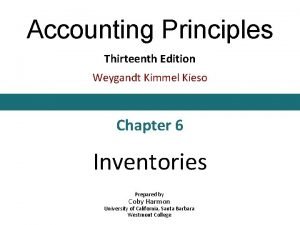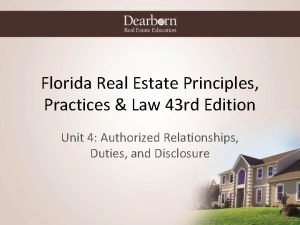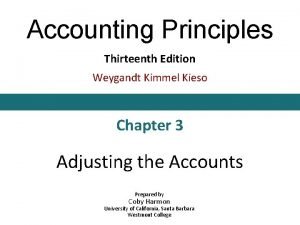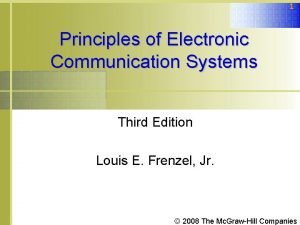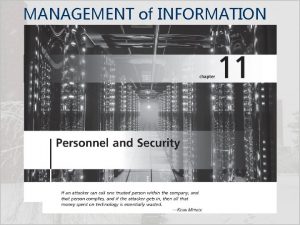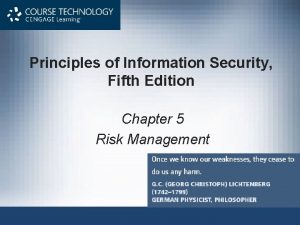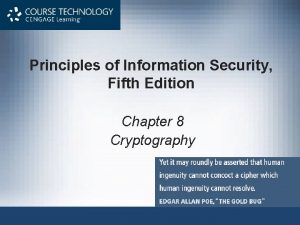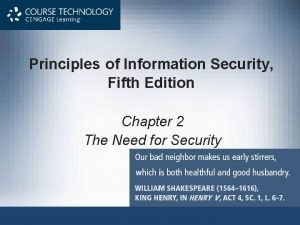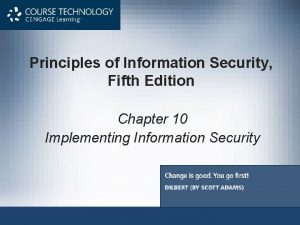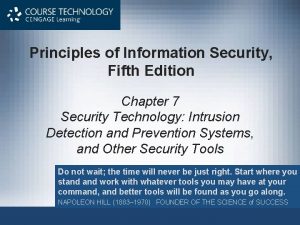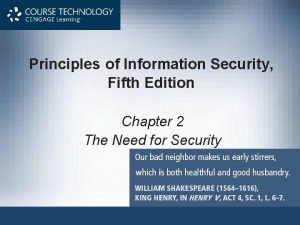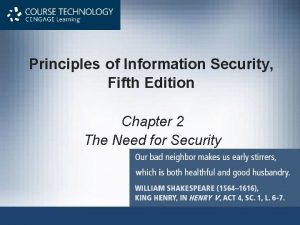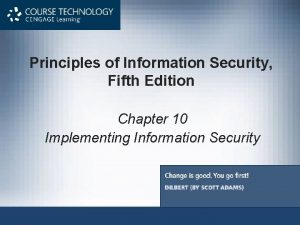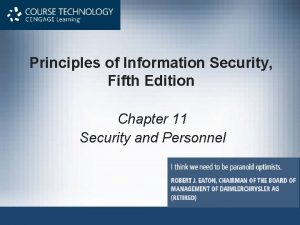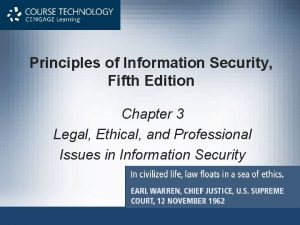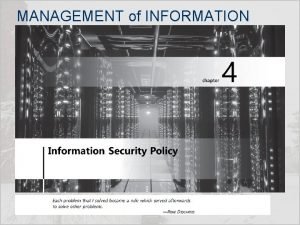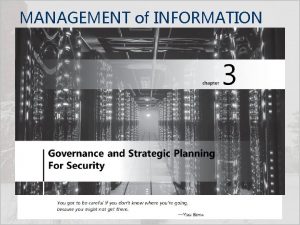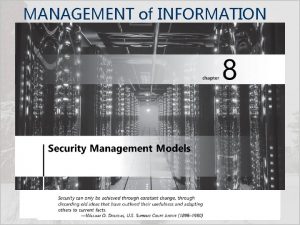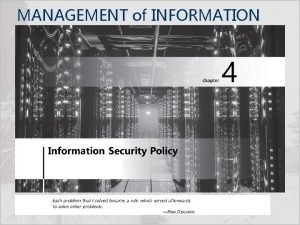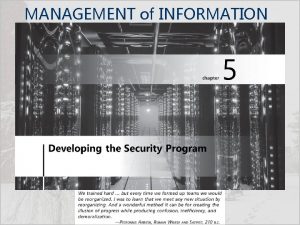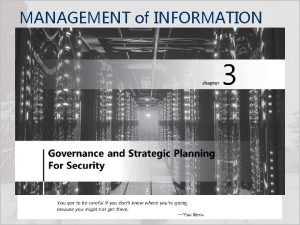Principles of Information Security Fifth Edition Chapter 11



















































- Slides: 51

Principles of Information Security, Fifth Edition Chapter 11 Security and Personnel

Learning Objectives • Upon completion of this material, you should be able to: – Describe where and how the information security function should be positioned within organizations – Explain the issues and concerns related to staffing the information security function – Enumerate the credentials that information security professionals can earn to gain recognition in the field – Discuss how an organization’s employment policies and practices can support the information security effort Principles of Information Security, Fifth Edition 2

Learning Objectives (cont’d) – Identify the special security precautions that must be taken when using contract workers – Explain the need for separation of duties – Describe the special requirements needed to ensure the privacy of personnel data Principles of Information Security, Fifth Edition 3

Introduction • When implementing information security, there are many human resource issues that must be addressed. – Positioning and naming – Staffing – Assessing impact of information security on every IT function – Integrating solid information security concepts into personnel management practices • Employees often feel threatened when information security program is being created/enhanced. Principles of Information Security, Fifth Edition 4

Positioning and Staffing the Security Function • The security function can be placed within: – – – IT function Physical security function Administrative services function Insurance and risk management function Legal department • IS should balance duty to monitor compliance with needs for education, training, awareness, and customer service. Principles of Information Security, Fifth Edition 5

Staffing the Information Security Function • Selecting personnel is based on several criteria, including some not within the control of the organization (supply and demand). • Many professionals enter security market by gaining skills, experience, and credentials. • At present, information security industry is in a period of high demand. Principles of Information Security, Fifth Edition 6

Principles of Information Security, Fifth Edition 7

Principles of Information Security, Fifth Edition 8

Staffing the Information Security Function (cont’d) • Qualifications and requirements – Establishing better hiring practices requires the following: • General management should learn more about skills and qualifications for positions. • Upper management should learn about the budgetary needs of information security function. • IT and general management should grant appropriate levels of influence and prestige to information security. – Organizations typically look for technically qualified information security generalist. Principles of Information Security, Fifth Edition 9

Staffing the Information Security Function (cont’d) • Qualifications and requirements (cont’d) – Organizations look for candidates who understand: • How an organization operates at all levels • Information security is usually a management problem, not a technical problem • Importance of strong communications and writing skills • The role of policy in guiding security efforts • Most mainstream IT technologies • The terminology of IT and information security Principles of Information Security, Fifth Edition 10

Staffing the Information Security Function (cont’d) • Qualifications and requirements (cont’d) – Organizations look for information security professionals who understand (cont’d): • Threats facing an organization and how they can become attacks • How to protect an organization’s assets from information security attacks • How business solutions can be applied to solve specific information security problems Principles of Information Security, Fifth Edition 11

Staffing the Information Security Function (cont’d) • Entry into the information security profession – Many information security professionals enter the field through one of two career paths: • Law enforcement and military • Technical, working on security applications and processes – Today, students select and tailor degree programs to prepare for work in information security. – Organizations can foster greater professionalism by matching qualified candidates to clearly defined roles in information security. Principles of Information Security, Fifth Edition 12

Principles of Information Security, Fifth Edition 13

Staffing the Information Security Function (cont’d) • Information security positions – Use of standard job descriptions can increase the degree of professionalism and improve the consistency of roles and responsibilities between organizations. – Charles Cresson Wood’s book Information Security Roles and Responsibilities Made Easy offers a set of model job descriptions. Principles of Information Security, Fifth Edition 14

Principles of Information Security, Fifth Edition 15

Information Security Positions • Chief information security officer (CISO) – Top information security officer; frequently reports to chief information officer (CIO) – Manages the overall information security program – Drafts or approves information security policies – Works with the CIO on strategic plans – Develops information security budgets – Sets priorities for purchase/implementation of information security projects and technology Principles of Information Security, Fifth Edition 16

Information Security Positions (cont’d) • Chief information security officer (CISO) (cont’d) – Makes recruiting, hiring and firing decisions or recommendations – Acts as spokesperson for information security team – Typical qualifications: accreditation, graduate degree, experience • Chief security officer (CSO) – CISO’s position may be combined with physical security responsibilities – Knowledgeable in both IS requirements and “guards, gates, and guns” approach to security Principles of Information Security, Fifth Edition 17

Information Security Positions (cont’d) • Security manager – Accountable for day-to-day operation of information security program – Accomplishes objectives as identified by CISO, resolves issues identified by technicians – Typical qualifications: often have accreditation; ability to draft middle- and lower-level policies, standards, and guidelines; budgeting, project management, and hiring and firing; ability to manage technicians Principles of Information Security, Fifth Edition 18

Information Security Positions (cont’d) • Security technician – Technically qualified employees tasked to configure security hardware and software – Tend to be specialized – Typical qualifications: • Varied; organizations prefer expert, certified, proficient technician • Some experience with a particular hardware and software package • Actual experience in using a technology usually required Principles of Information Security, Fifth Edition 19

Credentials for Information Security Professionals • Many organizations seek industry-recognized certifications. • Most existing certifications are relatively new and not fully understood by hiring organizations. Principles of Information Security, Fifth Edition 20

Certifications • (ISC)2 Certifications – – Certified Information Systems Security Professional (CISSP) Systems Security Certified Practitioner (SSCP) Certified Secure Software Lifecycle Professional (CSSLP) Associate of (ISC)2 • ISACA Certifications – – Certified Information Systems Manager(CISM) Certified Information Security Auditor (CISA) Certified in the Governance of Enterprise IT (CGEIT) Certified in Risk and Information Systems Control (CRISC) Principles of Information Security, Fifth Edition 21

Certifications (cont’d) • SANS Global Information Assurance Certification (GIAC) • EC Council Certified CISO (Cl. CISO) • Comp. TIA’s Security+ • Certified Computer Examiner (CCE) Principles of Information Security, Fifth Edition 22

Certification Costs • More preferred certifications can be expensive. • Even experienced professionals find exams difficult without some review. • Many candidates engage in individual or group study sessions and purchase exam review books. • Before attempting a certification exam, do all homework and review exam criteria, its purpose, and requirements to ensure that the time and energy spent pursuing certification are worthwhile. Principles of Information Security, Fifth Edition 23

Principles of Information Security, Fifth Edition 24

Advice for Information Security Professionals • Always remember: business before technology • Technology provides elegant solutions for some problems, but only exacerbates others. • Never lose sight of goal: protection. • Be heard and not seen. • Know more than you say; be more skillful than you let on. • Speak to users, not at them. • Your education is never complete. Principles of Information Security, Fifth Edition 25

Employment Policies and Practices • An organization should make information security a documented part of every employee’s job description. • Management community of interest should integrate solid concepts for information security into the organization’s employment policies and practices. Principles of Information Security, Fifth Edition 26

Employment Policies and Practices (cont’d) • From information security perspective, hiring of employees is a responsibility laden with potential security pitfalls. • CISO and information security manager should work with Human Resources department to incorporate information security into guidelines used for hiring all personnel. Principles of Information Security, Fifth Edition 27

Job Descriptions • Integrating information security perspectives into hiring process begins with reviewing and updating all job descriptions. • An organization should avoid revealing access privileges to prospective employees when advertising open positions. Principles of Information Security, Fifth Edition 28

Interviews • An opening within the information security department creates a unique opportunity for the security manager to educate HR on certifications, experience, and qualifications of a good candidate. • Information security should advise HR to limit information provided to the candidate on the responsibilities and access rights of the new hire. • For the organizations that include on-site visits as part of interviews, it’s important to exercise caution when showing candidate around facility. Principles of Information Security, Fifth Edition 29

Principles of Information Security, Fifth Edition 30

Background Checks • Should be conducted before organization extends offer to a candidate • Investigation into a candidate’s past • Background checks differ in the level of detail and depth with which a candidate is examined. • May include identity check, education and credential check, previous employment verification, references check, worker’s compensation history, motor vehicle records, drug history, credit history, and more Principles of Information Security, Fifth Edition 31

Employment Contracts • Once a candidate has accepted a job offer, employment contract becomes an important security instrument. • Many security policies require an employee to agree in writing to monitoring and nondisclosure agreements. • Policies governing employee behavior may be classified as “employment contingent upon agreement, ” whereby employee must agree to conform with the policies before being hired. Principles of Information Security, Fifth Edition 32

New Hire Orientation • New employees should receive extensive information security briefing on policies, procedures, and requirements for information security. • Levels of authorized access should be outlined; training is provided on secure use of information systems • By the time employees start, they should be thoroughly briefed on security components and their rights and responsibilities. Principles of Information Security, Fifth Edition 33

On-the-Job Security Training • An organization should integrate security awareness education into job orientation and security training. • Keeping security at the forefront of employees’ minds helps minimize their mistakes and is an important part of information security awareness mission. • External and internal seminars should also be used to increase security awareness for all employees, particularly security employees. Principles of Information Security, Fifth Edition 34

Evaluating Performance • Organizations should incorporate information security components into employee performance evaluations. • Employees pay close attention to job performance evaluations. – Are more likely to take information security seriously if violations are documented in them Principles of Information Security, Fifth Edition 35

Termination • When employee leaves organization, securityrelated issues arise. • Key issue is continuity of protection of all information to which employee had access. • After having delivered keys, keycards, and other business property, the former employee should be escorted from the premises. • Many organizations use an exit interview to remind former employee of contractual obligations and to obtain feedback. Principles of Information Security, Fifth Edition 36

Principles of Information Security, Fifth Edition 37

Termination (cont’d) • Hostile departures include termination for cause, permanent downsizing, temporary layoffs, or some instances of quitting. – Before the employee is aware, all logical and keycard access is terminated. – Employee collects all belongings and surrenders all keys, keycards, and other company property. – Employee is then escorted out of the building. Principles of Information Security, Fifth Edition 38

Termination (cont’d) • Friendly departures include resignation, retirement, promotion, or relocation. – Employee may be notified well in advance of departure date. – More difficult for the security to maintain positive control over the employee’s access and information usage. – Employee accounts usually continue with new expiration date. – Employees come and go at will, collect their own belongings, and leave on their own. Principles of Information Security, Fifth Edition 39

Termination (cont’d) • Offices and information used by the employee must be inventoried; files stored or destroyed; and property returned to organizational stores. • Possible that employees foresee departure well in advance and begin collecting organizational information for their future employment • Only by scrutinizing systems logs after the employee has departed can the organization determine if there has been a breach of policy or a loss of information. • If information has been illegally copied or stolen, report an incident and follow the appropriate policy. Principles of Information Security, Fifth Edition 40

Security Considerations for Temporary Employees, Consultants, and Other Workers • Individuals not subject to screening, contractual obligations, and eventual secured termination often have access to sensitive organizational information. • Relationships with these individuals should be carefully managed to prevent possible information leak or theft. Principles of Information Security, Fifth Edition 41

Temporary Employees • Hired by the organization to serve in temporary position or to supplement existing workforce • Often not subject to contractual obligations or general policies; if temporary employees violate a policy or cause a problem, possible actions are limited • Access to information for temporary employees should be limited to that necessary to perform duties • Temporary employee’s supervisor must restrict the information to which access is possible. Principles of Information Security, Fifth Edition 42

Contract Employees • Typically hired to perform specific services for organization • Host company often makes contract with a parent organization rather than with an individual for a particular task. • In a secure facility, all contract employees are escorted from room to room, as well as into and out of facility. • There is need for restrictions or requirements to be negotiated into contract agreements when they are activated. Principles of Information Security, Fifth Edition 43

Consultants • Contracts for consultants should specify all requirements for information or facility access before being allowed into workplace. • Security and technology consultants must be prescreened, escorted, and subjected to nondisclosure agreements to protect the organization. • Just because the organization is paying an information security consultant, the protection of their information doesn’t become the consultant’s top priority. Principles of Information Security, Fifth Edition 44

Business Partners • Businesses create strategic alliances with other organizations, desiring to exchange information, integrate systems, or discuss operations. • There must be meticulous, deliberate determination of what information is to be exchanged, in what format, and to whom. • Nondisclosure agreements and the security levels of both systems must be examined before any physical integration takes place. Principles of Information Security, Fifth Edition 45

Internal Control Strategies • Separation of duties is a cornerstone in the protection of information assets and the prevention of financial loss. – Used to reduce chance that employee will violate information security; stipulates that completion of significant task requires at least two people • Two-man control: two individuals review and approve each other’s work before the task is categorized as finished. Principles of Information Security, Fifth Edition 46

Principles of Information Security, Fifth Edition 47

Internal Control Strategies (cont’d) • Job rotation: Employees know each others’ job skills. – Ensures no one employee performs actions that cannot be physically audited by another employee • Garden leave used by some companies to restrict the flow of proprietary information when an employee leaves to join a competitor • Least privilege: Only employees with real business need to use systems information are allowed to do so. Principles of Information Security, Fifth Edition 48

Privacy and the Security of Personnel Data • Organizations required by law to protect sensitive or personal employee information • Includes employee addresses, phone numbers, Social Security numbers, medical conditions, and family names and addresses • Information security groups should ensure these data receive at least the same level of protection as other important organization data. Principles of Information Security, Fifth Edition 49

Summary • Positioning the information security function within organizations • Issues and concerns about staffing information security • Professional credentials of information security professionals • Organizational employment policies and practices related to successful information security Principles of Information Security, Fifth Edition 50

Summary (cont’d) • Special security precautions for nonemployees • Separation of duties • Special requirements needed for the privacy of personnel data Principles of Information Security, Fifth Edition 51
 Principles of marketing fifth european edition
Principles of marketing fifth european edition Principles of information security 5th edition pdf
Principles of information security 5th edition pdf Principles of management information system
Principles of management information system Principles of information security 4th edition
Principles of information security 4th edition Principles of information security 4th edition
Principles of information security 4th edition Bulls eye model in information security
Bulls eye model in information security Lazarus cognitive appraisal theory
Lazarus cognitive appraisal theory Fundamentals of corporate finance fifth edition
Fundamentals of corporate finance fifth edition Fifth edition chemistry a molecular approach
Fifth edition chemistry a molecular approach Mitosis
Mitosis Molecular biology
Molecular biology Human anatomy fifth edition
Human anatomy fifth edition Human anatomy fifth edition
Human anatomy fifth edition Computer security principles and practice 4th edition
Computer security principles and practice 4th edition Computer security principles and practice 4th edition
Computer security principles and practice 4th edition Management of information security 5th edition
Management of information security 5th edition Private secruity
Private secruity Principles of information systems 11th edition
Principles of information systems 11th edition Visa international security model diagram
Visa international security model diagram Explain about cnss security model
Explain about cnss security model Security in computing 5th edition ppt
Security in computing 5th edition ppt Nist sp 800-55
Nist sp 800-55 12 principles of information security
12 principles of information security Using mis 10th edition
Using mis 10th edition Report
Report The harder you push the harder the system pushes back
The harder you push the harder the system pushes back Fifth chapter menu
Fifth chapter menu Chapter 9 information management and security
Chapter 9 information management and security Introduction to information security chapter 2
Introduction to information security chapter 2 William stallings network security essentials 5th edition
William stallings network security essentials 5th edition Cryptography and network security 6th edition
Cryptography and network security 6th edition Cryptography and network security 6th edition pdf
Cryptography and network security 6th edition pdf Cryptography and network security 4th edition
Cryptography and network security 4th edition Security in computing 5th edition answers
Security in computing 5th edition answers Computer security fundamentals 4th edition
Computer security fundamentals 4th edition Network security essentials 5th edition
Network security essentials 5th edition Pearson cryptography and network security
Pearson cryptography and network security Principles of electronic communication systems 3rd edition
Principles of electronic communication systems 3rd edition Principles of economics third edition pdf
Principles of economics third edition pdf Accounting principles second canadian edition
Accounting principles second canadian edition Accounting principles second canadian edition
Accounting principles second canadian edition Accounting principles second canadian edition
Accounting principles second canadian edition Principles of management stephen p robbins
Principles of management stephen p robbins Florida real estate principles practices & law 43rd edition
Florida real estate principles practices & law 43rd edition Accounting principles 13th edition
Accounting principles 13th edition Accounting principles second canadian edition
Accounting principles second canadian edition Marketing management (arab world edition)
Marketing management (arab world edition) Florida real estate principles practices
Florida real estate principles practices Principles of electric circuits 10th edition answer key
Principles of electric circuits 10th edition answer key Accounting principles 13th edition
Accounting principles 13th edition Principles of electronic communication systems 3rd edition
Principles of electronic communication systems 3rd edition Chapter 2 principles of marketing
Chapter 2 principles of marketing



